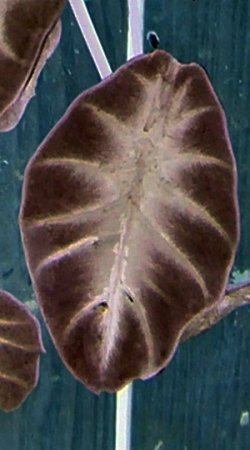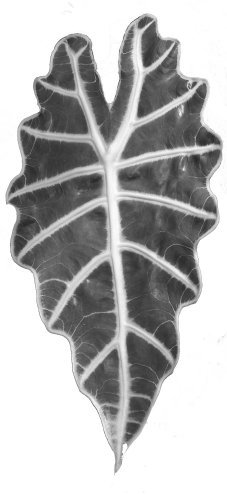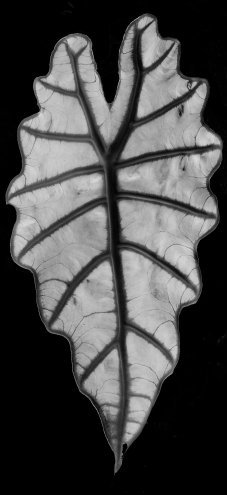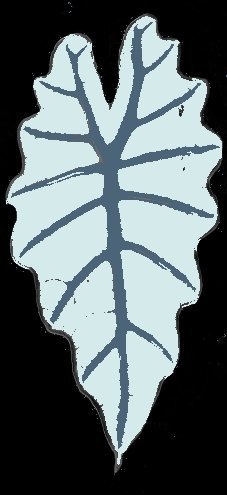





The colors on the leaves of this Blue Jewel are said to be the reverse of those on plants we've been looking at recently. Wait a minute, what does "reverse" mean here? The reverse of what? Let's explore this Jewel, and this dilemma, together - read on. . .
As we advance in our review of the Jewel Alocasias, we run into a bit of a roadblock, necessitating a movement in reverse. Did we miss something here? No, not really, because Alocasia reversa is unique in itself, not really the "reverse" of anything. However, the story is that the person who gave the specific name to this plant felt that the color scheme of these leaves was the reverse of what other Alocasia leaves looked like. Some have said that there are no Alocasia species with a coloration pattern that is the reverse of the leaves on this species. Study the thumbnail at right; have you ever seen a plant with colors the reverse of the ones you see here?
Before we look at this Jewel in more detail, I want to put to rest this question about "reverse" leaf colors. To do this, I'm going to rely on the magic of photo editing and show you exactly what the reverse of this leaf pattern would look like. First, let's look at a leaf from Alocasia reversa, and next to it, a reverse image of that same leaf:

 Now. study the leaf to the left, then look at the leaf to the right. Have you ever seen a species of Alocasia with a leaf that looks like the leaf on the right? Well, it does look a little like the leaf on Alocasia reginula, the Little Queen, but the vein coloration is too wide to be that plant. Hmmm. . .how about one of the other silver-veined Alocasia species, like Alocasia x amazonica?
Now. study the leaf to the left, then look at the leaf to the right. Have you ever seen a species of Alocasia with a leaf that looks like the leaf on the right? Well, it does look a little like the leaf on Alocasia reginula, the Little Queen, but the vein coloration is too wide to be that plant. Hmmm. . .how about one of the other silver-veined Alocasia species, like Alocasia x amazonica?
While you are pondering this dilemma, let's discuss the needs of this Blue Jewel. Alocasia reversa is similar in size to the other Jewel Alocasias we've covered in previous articles, and is also similar in cultural needs. The leaves on this plant are, predictably, thicker than those on garden-variety Alocasia species, but not so thick as the leaves on A. reginula or A. rugosa. This means that the Blue Jewel may take a bit more moisture than those two plants without succumbing to rot. However, that doesn't mean you can throw caution to the wind and water this plant indiscriminately! A. reversa hails from Borneo, more specifically, Sarawak, and grows in the forest over limestone, often on boulders. This means the roots are going to need plenty of aeration, much more so than in the typical soilless medium that ornamental plants are usually grown in. My suggestion is that you keep your Blue Jewel with your other Jewel Alocasias, and give them all the same care. Better to keep this one drier rather than wetter.
Ok, let's return to the dilemma of the color pattern on the leaves, and do so by taking a different tack. Below are a couple of shots of a leaf of Alocasia x amazonica, both in gray scale. One is the positive image and one is the negative image. Now, does the negative image leaf pattern look like the coloration pattern on A. reversa?

Not quite, huh? Well, perhaps we need to be a little more visionary. First of all, you have to imagine that you are an intrepid plant explorer hiking through uncharted territory in Borneo, crazed from heat and humidity, and probably haven't had a decent meal in days, if not weeks. Bug-eaten, sore, sweaty and dirty, haven't had a bath in a week, and you stumble upon this plant after stubbing your toe on a protruding piece of limestone rock. Cursing under your breath, you say to yourself that you should reverse course and head for civilization. But wait, what's this new plant you see? Through the salty sweat dripping into your eyes, the leaf pattern looks like the reverse of some of those silvery-veined specimens back at the botanical garden. Exhausted, you scribble "Alocasia reversa" in your grimy notebook, grab and bag a specimen, and head back to camp.
Fanciful? Yes, but perhaps not too far from the truth. Let's give this one last try and see if we can come up with a reverse shot of Alocasia x amazonica, but this time make the colors more like A. reversa
Did I get it right? No? Oh, well, we can only imagine what was in the mind of the person who gave this plant the specific name of "reversa". However, we need not imagine how to grow one of these beauties for ourselves. We just need to remember that this is one of the Jewels and, as such, needs royal attention.
Photo credit: LariAnn Garner, Aroidia Research
Copyright © www.100flowers.win Botanic Garden All Rights Reserved